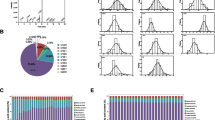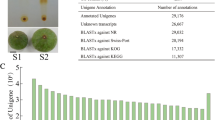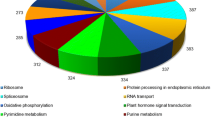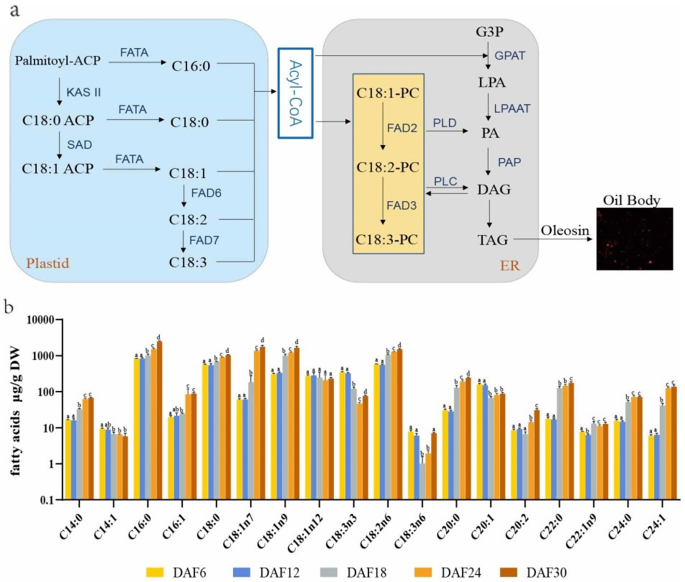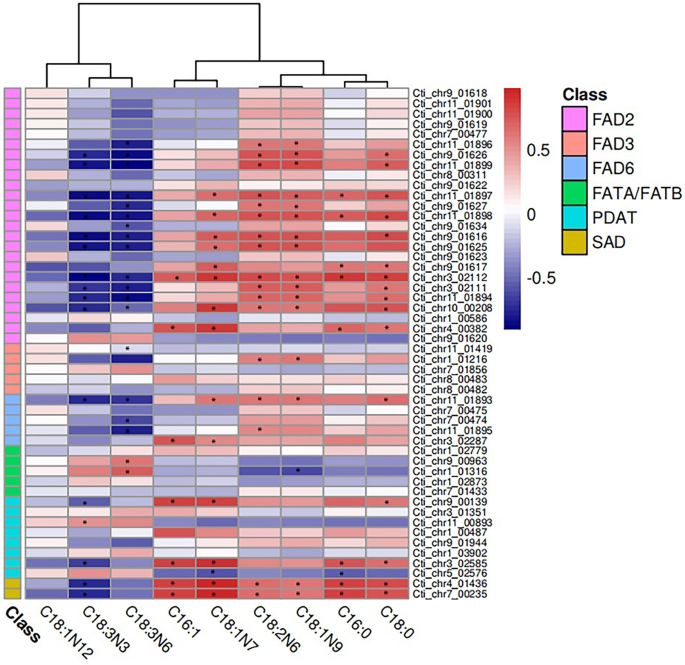Abstract
Domesticated safflower (Carthamus tinctorius L.) is a widely cultivated edible oil crop. However, despite its economic importance, the genetic basis underlying key traits such as oil content, resistance to biotic and abiotic stresses, and flowering time remains poorly understood. Here, we present the genome assembly for C. tinctorius variety Jihong01, which was obtained by integrating Oxford Nanopore Technologies (ONT) and BGI-SEQ500 sequencing results. The assembled genome was 1,061.1 Mb, and consisted of 32,379 protein-coding genes, 97.71% of which were functionally annotated. Safflower had a recent whole genome duplication (WGD) event in evolution history and diverged from sunflower approximately 37.3 million years ago. Through comparative genomic analysis at five seed development stages, we unveiled the pivotal roles of fatty acid desaturase 2 (FAD2) and fatty acid desaturase 6 (FAD6) in linoleic acid (LA) biosynthesis. Similarly, the differential gene expression analysis further reinforced the significance of these genes in regulating LA accumulation. Moreover, our investigation of seed fatty acid composition at different seed developmental stages unveiled the crucial roles of FAD2 and FAD6 in LA biosynthesis. These findings offer important insights into enhancing breeding programs for the improvement of quality traits and provide reference resource for further research on the natural properties of safflower.
Similar content being viewed by others
Introduction
Safflower (Carthamus tinctorius L.) is a diploid (2n = 24) dicot plant in the family Asteraceae (Compositae) [1]. It is an annual plant that is predominantly self-pollinated. This herbaceous crop is adapted to hot and dry environments due to its deep root system and xerophytic spines. Therefore, it is widely cultivated in arid and semiarid regions [2]. Safflower is assumed to have been domesticated in the Fertile Cresent region over 4,000 years ago, and it has a long history of cultivation in Asia, the Mediterranean region, Europe, and the Americas [3,4,5].
Safflower is mainly grown as an oil crop, it has been cultivated for use as birdseed and as a source of oil for the paint industry [6, 7]. In some areas such as Western Europe, safflower is cultivated as a source of Safflor Yellow (SY) that is produced in the floret, and used as a natural dyestuff [8]. Safflower is valuable as an edible oil crop because it produces a large amount of oil (approx. 25% oil content in seeds). It has relatively higher polyunsaturated/saturated ratios than other edible oil, which is rich in octadecadienoic acid and contains more than 70% LA [9]. As a type of essential polyunsaturated fatty acid (PUFA), LA is vital in the dietary composition for both humans and animals. As one of the oldest sources of oil for humans worldwide, the main economic traits of cultivated safflower varieties are related to its composition proportion in LA [10, 11]. Fatty acids desaturase such as FAD2 play a crucial role in regulating the composition of fatty acids, including LA. These enzymes catalyze the desaturation reactions necessary for the synthesis of unsaturated fatty acids, from saturated or monounsaturated precursors [12]. Although, it is not a mainstream oilseed crop in today’s world, it has been cultivated widely and distributed across various geographic regions. The species diversity of safflower could also serve as an important resource for genetic breeding.
The genetic diversity and natural variations in safflower have been studied using several molecular and analytical methods in recent decades [3, 13]. More recent studies have provided molecular information for safflower including its complete chloroplast genome [14], full-length transcriptome [15], and the locations of 2,008,196 single nucleotide polymorphisms, which were identified from recombinant inbred safflower lines [16]. The results of those studies and others indicated that the genetic architecture and evolution of safflower domestication are complex [17]. Such complexity has posed challenges to safflower breeding endeavors. In the past, breeding programs have used hybridization to breed new cultivars [18] and have characterized the safflower germplasm using various molecular markers, including expressed sequence tags, inter simple sequence repeats, single nucleotide polymorphism, and simple sequence repeat markers [15, 19,20,21,22]. Genome evolution involves intricate mechanisms such as gene duplication, divergence, and selection, which shape the genetic landscape of organisms over time. Gene duplication, in particular, serves as a significant driver of genome evolution, often leading to the expansion of gene families [23, 24]. Therefore, high-quality safflower reference genome and genome evolution research can reveal genetic structure and phylogenetic details, as well as biosynthesis processes of bioactive compounds. The inaugural sequencing of the safflower cultivar Anhui-1 genome employed PacBio Sequel (Pacific Biosciences) in conjunction with the Illumina Hiseq 2500 sequencing platform. The investigation primarily targeted the biosynthetic pathways of hydroxysafflor yellow A and unsaturated fatty acid [5b). The contents of oleic acid (C18:1) and linoleic acid (C18:2) were found the highest at maturity stage. For instance, C18:1n7, C18:1n9 and C18:2n6 reached 1,776, 1,666, 1,510 µg/g DW, increased by 29.9, 5.4, and 2.6 times when compared to the early stages of grain formation, respectively. According to the data results, C18:3n3 and C18:3n6 did not belong to the high content of PUFA, and their contents decreased first and then increased in the seed developmental stage. In addition to this, most of the fatty acids were increased in the seeds except C14:1, which was decreased. The composition and content of fatty acids in safflower seeds during seed development indicated that the synthesis and accumulation of polyunsaturated fatty acids C18:2 was the main factor determining the oil quality of safflower seeds.
To gain a better understanding of the relationship between genes and fatty acids species, the Pearson correlation test was performed for the intensity of fatty acids and the expression pattern of genes during the safflower seeds development stage. Our results showed that a total of 28 genes were significantly correlated with C18:1, C18:2 and C18:3 molecular species metabolites that exhibit a Pearson correlation coefficient > 0.7 and p-value < 0.05. Among them, expression pattern of 15 FAD2 genes (Cti _chr11_01896, Cti_chr9_01626, Cti_chr11_01899, Cti_chr11_01897, Cti_ chr9_01627, Cti_chr11_01898, Cti_chr9_01634, Cti_chr9_01616, Cti_chr9_01625, Cti_chr9_01617, Cti_chr3_02112, Cti_chr3_02111, Cti_chr11_01894, Cti_chr10_00208, Cti_chr4_00382) and 4 FAD6 genes (Cti_chr11_01893, Cti_chr7_00474, Cti_chr11_01895, Cti_chr3_02287) were positively correlated with C18:1n7, C18:1n9 and C18:2n6 composition patterns during seed develo** stages (Fig. 6). Importantly, two FAD6 genes Cti_chr11_01893 and Cti_chr11_01895 expression patterns showed significant correlation with C18:2 contents during seed development stage. These results indicated that FAD2 and FAD6 genes appear to be responsible for the high proportion of C18:2 in develo** safflower seeds.
Fatty acids biosynthesis and contents of seed lipids. (a) Fatty acid and oil biosynthesis in safflower. KAS II, β-ketoacyl-ACP synthetase; SAD, stromal stearoyl-ACP desaturase; FATA, acyl-ACP thioesterase; G3P, glycerol-3-phosphate; GPAT, glycerol-3-phosphate acyltransferase; LPA, lysophosphatidic acid; LPAAT, Lysophosphatidic acid acyltransferase; PA, phosphatidic acid; FAD2/3/6/7, Fatty acid desaturase; DAG, diglycerides; TAG, triglycerides; (b) Fatty acids contents of seed storage lipids in different develo** stages
Discussion
In the present study, we report the complete genome sequence of an economically important crop safflower. We presented valuable insights into the genetic organization of safflower, which facilitates the identification of key functional genes implicated in fatty acid synthesis. These valuable genomic resources could be easily accessible to researchers in the field for future functional and molecular breeding studies. Previous studies on the Compositae have reported genome sequences for H. annuus [31], lettuce (Lactuca sativa) [ The raw sequence reads were deposited in China National GeneBank DataBase (CNGB db) under Project No. CNP0004859 and CNP0004861. Chapman MA, Burke JM. DNA sequence diversity and the origin of cultivated safflower (Carthamus tinctorius L.; Asteraceae). BMC Plant Biol. 2007;7:60. Dajue L, Mündel H-H. Safflower, Carthamus Tinctorius L. Volume 7. Bioversity International; 1996. Panahi B, Ghorbanzadeh Neghab M. Genetic characterization of Iranian safflower (Carthamus tinctorius) using inter simple sequence repeats (ISSR) markers. Physiol Mol Biology Plants: Int J Funct Plant Biology. 2013;19(2):239–43. McPherson MA, Good AG, Topinka AK, Yang RC, McKenzie RH, Cathcart RJ, Christianson JA, Strobeck C, Hall LM. Pollen-mediated gene flow from transgenic safflower (Carthamus tinctorius L.) intended for plant molecular farming to conventional safflower. Environ Biosaf Res. 2009;8(1):19–32. Ahmad N, Li T, Liu Y, Hoang NQV, Ma X, Zhang X, Liu J, Yao N, Liu X, Li H. Molecular and biochemical rhythms in dihydroflavonol 4-reductase-mediated regulation of leucoanthocyanidin biosynthesis in Carthamus tinctorius L. Industrial Crops Prod. 2020;156:112838. Cao S, Zhou XR, Wood CC, Green AG, Singh SP, Liu L, Liu Q. A large and functionally diverse family of Fad2 genes in safflower (Carthamus tinctorius L). BMC Plant Biol. 2013;13:5. Matthaus B, Ozcan MM, Al Juhaimi FY. Fatty acid composition and tocopherol profiles of safflower (Carthamus tinctorius L.) seed oils. Nat Prod Res. 2015;29(2):193–6. Hou Y, Wang Y, Liu X, Ahmad N, Wang N, ** L, Yao N, Liu X. A cinnamate 4-HYDROXYLASE1 from Safflower promotes flavonoids Accumulation and stimulates antioxidant Defense System in Arabidopsis. Int J Mol Sci. 2023;24(6):5393. Rapson S, Wu M, Okada S, Das A, Shrestha P, Zhou XR, Wood C, Green A, Singh S, Liu Q. A case study on the genetic origin of the high oleic acid trait through FAD2-1 DNA sequence variation in safflower (Carthamus tinctorius L). Front Plant Sci. 2015;6:691. Li R, Beaudoin F, Ammah AA, Bissonnette N, Benchaar C, Zhao X, Lei C, Ibeagha-Awemu EM. Deep sequencing shows microRNA involvement in bovine mammary gland adaptation to diets supplemented with linseed oil or safflower oil. BMC Genomics. 2015;16:884. Kazuma K, Takahashi T, Sato K, Takeuchi H, Matsumoto T, Okuno T. Quinochalcones and flavonoids from fresh florets in different cultivars of Carthamus tinctorius L. Biosci Biotechnol Biochem. 2000;64(8):1588–99. Nguyen VC, Nakamura Y, Kanehara K. Membrane lipid polyunsaturation mediated by FATTY ACID DESATURASE 2 (FAD2) is involved in endoplasmic reticulum stress tolerance in Arabidopsis thaliana. Plant Journal: Cell Mol Biology. 2019;99(3):478–93. Sehgal D, Rajpal VR, Raina SN, Sasanuma T, Sasakuma T. Assaying polymorphism at DNA level for genetic diversity diagnostics of the safflower (Carthamus tinctorius L.) world germplasm resources. Genetica. 2009;135(3):457–70. Lu C, Shen Q, Yang J, Wang B, Song C. The complete chloroplast genome sequence of Safflower (Carthamus tinctorius L). Mitochondrial DNA Part DNA Mapp Sequencing Anal. 2016;27(5):3351–3. Chen J, Tang X, Ren C, Wei B, Wu Y, Wu Q, Pei J. Full-length transcriptome sequences and the identification of putative genes for flavonoid biosynthesis in safflower. BMC Genomics. 2018;19(1):548. Bowers JE, Pearl SA, Burke JM. Genetic Map** of Millions of SNPs in Safflower (Carthamus tinctorius L.) via Whole-Genome Resequencing. G3 2016, 6(7):2203–2211. Pearl SA, Bowers JE, Reyes-Chin-Wo S, Michelmore RW, Burke JM. Genetic analysis of safflower domestication. BMC Plant Biol. 2014;14:43. Mayerhofer M, Mayerhofer R, Topinka D, Christianson J, Good AG. Introgression potential between safflower (Carthamus tinctorius) and wild relatives of the genus Carthamus. BMC Plant Biol. 2011;11:47. Pearl SA, Burke JM. Genetic diversity in Carthamus tinctorius (Asteraceae; safflower), an underutilized oilseed crop. Am J Bot. 2014;101(10):1640–50. Lee GA, Sung JS, Lee SY, Chung JW, Yi JY, Kim YG, Lee MC. Genetic assessment of safflower (Carthamus tinctorius L.) collection with microsatellite markers acquired via pyrosequencing method. Mol Ecol Resour. 2014;14(1):69–78. Chapman MA, Hvala J, Strever J, Matvienko M, Kozik A, Michelmore RW, Tang S, Knapp SJ, Burke JM. Development, polymorphism, and cross-taxon utility of EST–SSR markers from safflower (Carthamus tinctorius L). Theor Appl Genet. 2009;120(1):85–91. Yang Y-X, Wu W, Zheng Y-L, Chen L, Liu R-J, Huang C-Y. Genetic diversity and relationships among safflower (Carthamus tinctorius L.) analyzed by inter-simple sequence repeats (ISSRs). Genet Resour Crop Evol. 2007;54(5):1043–51. Kondrashov FA, Rogozin IB, Wolf YI, Koonin EV. Selection in the evolution of gene duplications. Genome Biol. 2002;3(2):Research0008. Panchy N, Lehti-Shiu M, Shiu SH. Evolution of gene duplication in plants. Plant Physiol. 2016;171(4):2294–316. Wu Z, Liu H, Zhan W, Yu Z, Qin E, Liu S, Yang T, **ang N, Kudrna D, Chen Y, et al. The chromosome-scale reference genome of safflower (Carthamus tinctorius) provides insights into linoleic acid and flavonoid biosynthesis. Plant Biotechnol J. 2021;19(9):1725–42. Walker BJ, Abeel T, Shea T, Priest M, Abouelliel A, Sakthikumar S, Cuomo CA, Zeng Q, Wortman J, Young SK, et al. Pilon: an integrated tool for comprehensive microbial variant detection and genome assembly improvement. PLoS ONE. 2014;9(11):e112963. Huang S, Kang M, Xu A. HaploMerger2: rebuilding both haploid sub-assemblies from high-heterozygosity diploid genome assembly. Bioinformatics. 2017;33(16):2577–9. Simao FA, Waterhouse RM, Ioannidis P, Kriventseva EV, Zdobnov EM. BUSCO: assessing genome assembly and annotation completeness with single-copy orthologs. Bioinformatics. 2015;31(19):3210–2. Ou S, Chen J, Jiang N. Assessing genome assembly quality using the LTR Assembly Index (LAI). Nucleic Acids Res. 2018;46(21):e126. Scaglione D, Reyes-Chin-Wo S, Acquadro A, Froenicke L, Portis E, Beitel C, Tirone M, Mauro R, Lo Monaco A, Mauromicale G, et al. The genome sequence of the outbreeding globe artichoke constructed de novo incorporating a phase-aware low-pass sequencing strategy of F1 progeny. Sci Rep. 2016;6:19427. Badouin H, Gouzy J, Grassa CJ, Murat F, Staton SE, Cottret L, Lelandais-Briere C, Owens GL, Carrere S, Mayjonade B, et al. The sunflower genome provides insights into oil metabolism, flowering and Asterid evolution. Nature. 2017;546(7656):148–52. Reyes-Chin-Wo S, Wang Z, Yang X, Kozik A, Arikit S, Song C, **a L, Froenicke L, Lavelle DO, Truco MJ, et al. Genome assembly with in vitro proximity ligation data and whole-genome triplication in lettuce. Nat Commun. 2017;8:14953. Barreda VD, Palazzesi L, Tellería MC, Olivero EB, Raine JI, Forest F. Early evolution of the angiosperm clade Asteraceae in the Cretaceous of Antarctica. Proceedings of the National Academy of Sciences 2015, 112(35):10989–10994. Barker MS, Kane NC, Matvienko M, Kozik A, Michelmore RW, Knapp SJ, Rieseberg LH. Multiple paleopolyploidizations during the evolution of the Compositae reveal parallel patterns of duplicate gene retention after millions of years. Mol Biol Evol. 2008;25(11):2445–55. Li L, Stoeckert CJ Jr., Roos DS. OrthoMCL: identification of ortholog groups for eukaryotic genomes. Genome Res. 2003;13(9):2178–89. De Bie T, Cristianini N, Demuth JP, Hahn MW. CAFE: a computational tool for the study of gene family evolution. Bioinformatics. 2006;22(10):1269–71. Zwaenepoel A, Van de Peer Y. Wgd-simple command line tools for the analysis of ancient whole-genome duplications. Bioinformatics. 2019;35(12):2153–5. Wang Z, Hobson N, Galindo L, Zhu S, Shi D, McDill J, Yang L, Hawkins S, Neutelings G, Datla R, et al. The genome of flax (Linum usitatissimum) assembled de novo from short shotgun sequence reads. Plant Journal: Cell Mol Biology. 2012;72(3):461–73. Kumar L. Mfuzz: a software package for soft clustering of microarray data. Bioinformation. 2007;2(1):5–7. Garnatje T, Garcia S, Vilatersana R, Vallès J. Genome size variation in the genus Carthamus (Asteraceae, Cardueae): systematic implications and additive changes during allopolyploidization. Ann Bot. 2006;97(3):461–7. Sabzalian MR, Saeidi G, Mirlohi A. Oil content and fatty acid composition in seeds of three safflower species. J Am Oil Chem Soc. 2008;85(8):717–21. Wei X, Liu K, Zhang Y, Feng Q, Wang L, Zhao Y, Li D, Zhao Q, Zhu X, Zhu X, et al. Genetic discovery for oil production and quality in sesame. Nat Commun. 2015;6:8609. Bozan B, Temelli F. Chemical composition and oxidative stability of flax, safflower and poppy seed and seed oils. Bioresour Technol. 2008;99(14):6354–9. Ma DW, Wierzbicki AA, Field CJ, Clandinin MT. Preparation of conjugated linoleic acid from safflower oil. J Am Oil Chem Soc. 1999;76(6):729–30. Jaillon O, Aury JM, Noel B, Policriti A, Clepet C, Casagrande A, Choisne N, Aubourg S, Vitulo N, Jubin C, et al. The grapevine genome sequence suggests ancestral hexaploidization in major angiosperm phyla. Nature. 2007;449(7161):463–7. Kim S, Park M, Yeom S-I, Kim Y-M, Lee JM, Lee H-A, Seo E, Choi J, Cheong K, Kim K-T. Genome sequence of the hot pepper provides insights into the evolution of pungency in Capsicum species. Nat Genet. 2014;46(3):270–8. Arabidopsis Genome I. Analysis of the genome sequence of the flowering plant Arabidopsis thaliana. Nature. 2000;408(6814):796–815. Roth C, Rastogi S, Arvestad L, Dittmar K, Light S, Ekman D, Liberles DA. Evolution after gene duplication: models, mechanisms, sequences, systems, and organisms. J Experimental Zool Part B Mol Dev Evol. 2007;308(1):58–73. Kim S, Park M, Yeom SI, Kim YM, Lee JM, Lee HA, Seo E, Choi J, Cheong K, Kim KT, et al. Genome sequence of the hot pepper provides insights into the evolution of pungency in Capsicum species. Nat Genet. 2014;46(3):270–8. Ibarra-Laclette E, Lyons E, Hernandez-Guzman G, Perez-Torres CA, Carretero-Paulet L, Chang TH, Lan T, Welch AJ, Juarez MJ, Simpson J, et al. Architecture and evolution of a minute plant genome. Nature. 2013;498(7452):94–8. Li Y, Beisson F, Pollard M, Ohlrogge J. Oil content of Arabidopsis seeds: the influence of seed anatomy, light and plant-to-plant variation. Phytochemistry. 2006;67(9):904–15. Marcais G, Kingsford C. A fast, lock-free approach for efficient parallel counting of occurrences of k-mers. Bioinformatics. 2011;27(6):764–70. Vurture GW, Sedlazeck FJ, Nattestad M, Underwood CJ, Fang H, Gurtowski J, Schatz MC. GenomeScope: fast reference-free genome profiling from short reads. Bioinformatics. 2017;33(14):2202–4. Servant N, Varoquaux N, Lajoie BR, Viara E, Chen CJ, Vert JP, Heard E, Dekker J, Barillot E. HiC-Pro: an optimized and flexible pipeline for Hi-C data processing. Genome Biol. 2015;16:259. Durand NC, Shamim MS, Machol I, Rao SS, Huntley MH, Lander ES, Aiden EL. Juicer provides a one-click system for analyzing Loop-Resolution Hi-C experiments. Cell Syst. 2016;3(1):95–8. Dudchenko O, Batra SS, Omer AD, Nyquist SK, Hoeger M, Durand NC, Shamim MS, Machol I, Lander ES, Aiden AP, et al. De novo assembly of the Aedes aegypti genome using Hi-C yields chromosome-length scaffolds. Science. 2017;356:92–5. RepeatModeler. Open-1.0 [http://www.repeatmasker.org]. Xu Z, Wang H. LTR_FINDER: an efficient tool for the prediction of full-length LTR retrotransposons. Nucleic Acids Res 2007, 35(Web Server issue):W265–268. Benson G. Tandem repeats finder: a program to analyze DNA sequences. Nucleic Acids Res. 1999;27(2):573–80. Edgar RC. MUSCLE: multiple sequence alignment with high accuracy and high throughput. Nucleic Acids Res. 2004;32(5):1792–7. Hu TT, Pattyn P, Bakker EG, Cao J, Cheng JF, Clark RM, Fahlgren N, Fawcett JA, Grimwood J, Gundlach H, et al. The Arabidopsis lyrata genome sequence and the basis of rapid genome size change. Nat Genet. 2011;43(5):476–81. Ossowski S, Schneeberger K, Lucas-Lledo JI, Warthmann N, Clark RM, Shaw RG, Weigel D, Lynch M. The rate and molecular spectrum of spontaneous mutations in Arabidopsis thaliana. Science. 2010;327(5961):92–4. Kent WJ. BLAT–the BLAST-like alignment tool. Genome Res. 2002;12(4):656–64. Birney E, Clamp M, Durbin R. GeneWise and Genomewise. Genome Res. 2004;14(5):988–95. Kim D, Langmead B, Salzberg SL. HISAT: a fast spliced aligner with low memory requirements. Nat Methods. 2015;12(4):357–60. Pertea M, Pertea GM, Antonescu CM, Chang TC, Mendell JT, Salzberg SL. StringTie enables improved reconstruction of a transcriptome from RNA-seq reads. Nat Biotechnol. 2015;33(3):290–5. Elsik CG, Mackey AJ, Reese JT, Milshina NV, Roos DS, Weinstock GM. Creating a honey bee consensus gene set. Genome Biol. 2007;8(1):R13. Jones P, Binns D, Chang HY, Fraser M, Li W, McAnulla C, McWilliam H, Maslen J, Mitchell A, Nuka G, et al. InterProScan 5: genome-scale protein function classification. Bioinformatics. 2014;30(9):1236–40. Stamatakis A. RAxML version 8: a tool for phylogenetic analysis and post-analysis of large phylogenies. Bioinformatics. 2014;30(9):1312–3. Yang Z. PAML 4: phylogenetic analysis by maximum likelihood. Mol Biol Evol. 2007;24(8):1586–91. Tang H, Bowers JE, Wang X, Ming R, Alam M, Paterson AH. Synteny and Collinearity in Plant genomes. Science. 2008;320:486–8. Ecker J, Scherer M, Schmitz G, Liebisch G. A rapid GC-MS method for quantification of positional and geometric isomers of fatty acid methyl esters. J Chromatogr B Analyt Technol Biomed Life Sci. 2012;897:98–104. This work was supported by China National GeneBank (CNGB). This research was funded by The Science and Technology Development Project of Jilin province (20210402044GH, 20220101354JC), Science and Technology Research Project of the Education Department of Jilin Province (JJKH20220325KJ). Y.D., X.W., X.L., and H.L. performed some data analyses. J.Y., N.Y. and L.D. managed samples and tissues. Y.W. prepared materials and uploaded data. Y.D., X.W., X.L., and J.Y. performed some data analyses and prepared graphics. N.Y., X.L., N.W., X.L., and W.L., prepared the libraries. H.L., and X.L. assisted in data analysis and in the overall design of the project. F.W., H.L., and X.L. developed the figure of the study and assisted with manuscript preparation. Y.D., X.W., N.A. Y.S. X.L., J.Y., F.W., and H.L. wrote and revised the manuscript. All of the authors reviewed and approved the final manuscript. No specific approval was required for voucher specimens for this study. Voucher specimens were prepared and deposited at the Jilin agricultural University. Yuanyuan Dong and **aojie Wang undertook the identification work of the plant material. The authors have complied with all relevant institutional and national guidelines and legislation in experimental research and field studies on plants, including the collection of plant materials for this study. Not applicable. The authors declare no competing interests. Springer Nature remains neutral with regard to jurisdictional claims in published maps and institutional affiliations. Below is the link to the electronic supplementary material. Open Access This article is licensed under a Creative Commons Attribution 4.0 International License, which permits use, sharing, adaptation, distribution and reproduction in any medium or format, as long as you give appropriate credit to the original author(s) and the source, provide a link to the Creative Commons licence, and indicate if changes were made. The images or other third party material in this article are included in the article’s Creative Commons licence, unless indicated otherwise in a credit line to the material. If material is not included in the article’s Creative Commons licence and your intended use is not permitted by statutory regulation or exceeds the permitted use, you will need to obtain permission directly from the copyright holder. To view a copy of this licence, visit http://creativecommons.org/licenses/by/4.0/. The Creative Commons Public Domain Dedication waiver (http://creativecommons.org/publicdomain/zero/1.0/) applies to the data made available in this article, unless otherwise stated in a credit line to the data. Dong, Y., Wang, X., Ahmad, N. et al. The Carthamus tinctorius L. genome sequence provides insights into synthesis of unsaturated fatty acids.
BMC Genomics 25, 510 (2024). https://doi.org/10.1186/s12864-024-10405-z Received: Accepted: Published: DOI: https://doi.org/10.1186/s12864-024-10405-zData availability
References
Acknowledgements
Funding
Author information
Authors and Affiliations
Contributions
Corresponding author
Ethics declarations
Ethics approval and consent to participate
Consent for publication
Competing interests
Additional information
Publisher’s Note
Electronic supplementary material
Rights and permissions
About this article
Cite this article
Keywords


